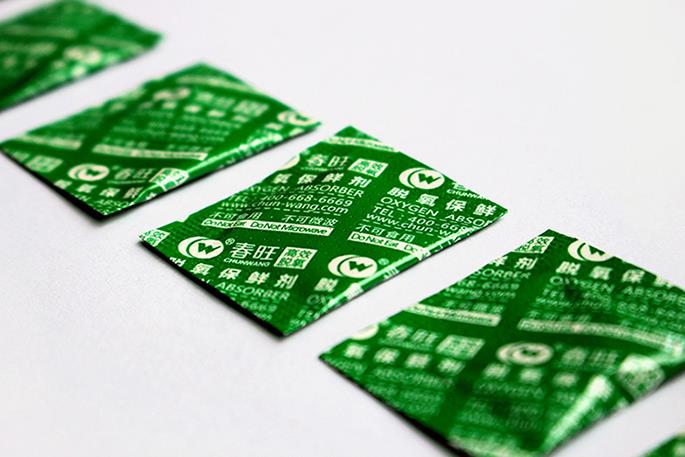The deoxidizer is also called a free oxygen absorber, oxygen absorber deoxidizer, a free oxygen remover, etc., which is a substance capable of absorbing oxygen. When the food is sealed and packaged, the oxidizing substance in the package can be removed at the same time, and free oxygen and dissolved oxygen in the packaging container are removed to prevent the food from being mildewed and deteriorated due to oxidation. The deoxidizer used in food can not only effectively inhibit the deterioration of the quality of the contents, but also maintain the original color, aroma, taste of the food, control the growth of pests and bacteria, and maintain nutrients, so the use of deoxidizer fresh food is a kind High quality, good effect, convenient and safe packaging preservation method.
As a new food preservation material, the deoxidizer can absorb the oxygen in the container, make the container anaerobic, and the food can be preserved. However, the raw material of the deoxidizer must have a stable reaction, no strange smell and no harmful gas generation, and it is harmless to the human body in case of eating. Deoxidizers are generally based on reduced iron powder and are used in general foods to maintain food quality and prolong retention. Use in healthy foods to prevent oxidation of oils, prevent fading and maintain nutrients. Deoxidizers have been widely used in foreign countries for wet bread flour, wet noodles, wet vermicelli, wet snacks, semi-dry fish products and other foods. At present, the deoxidizer form is in addition to the bag, and there is also a cap. The bag is used for bagged food, and the cap is used for containers such as bottles and cans. In recent years, with the development of the food industry and the improvement of packaging materials, deoxidizers have received more and more attention in China, and their applications have become more and more extensive.
1) Chinese and Western-style cakes: Mid-Autumn moon cakes, European cakes, waffles, Swiss rolls, Ma Department, mung bean cakes, rice cakes, walnut cakes, wife cakes, light cakes, almond cakes, etc.
2) Poultry meat products: beef jerky, chicken wings, sausage, ham, meat, meat, duck and so on.
3) Nut roasted seeds and nuts: pistachio, macadamia, almond, pine nuts, pecans, walnuts, chestnuts, peanuts, melon seeds, pumpkin seeds, multi-flavored beans, etc.
4) Aquatic dry food: dried abalone, dried fish, scallops, squid, seaweed, grilled fish fillets, etc.
5) Other mountain foods: tea, seaweed, laurel, dried lychee, dried mushrooms, jujube, dried wild vegetables, dehydrated vegetables, beans, persimmon cake, dried sweet potato, rice, etc.
6) Medicine and health products: Chinese herbal medicines, pharmaceuticals, health care products, etc.
7) Non-food products: precision instruments, military products, books, cultural relics, tobacco, etc.
8) Animal feed: bait, pet feed.

There are many methods for classifying deoxidizers, which can be classified according to the main ingredient:
1) Inorganic deoxidizer. The most commonly used are iron series deoxidizers and sulfite deoxidizers. After iron oxidation, Fe(OH)3 is formed. The deoxidizing capacity of 1 gram of iron is 300mL, which is equivalent to 1500mL of air. The oxygen removal effect is good and economical. The iron here is mainly the reduced iron powder, as well as the sand-like powder iron and the coarse iron.
2) Organic oxygen scavengers. For example, ascorbic acid has good oxygen scavenging ability; glucose basics produce a large amount of decomposition products under certain conditions to remove oxygen.
It can also be classified by reaction type:
1) High moisture food type. After the deoxidizer is sealed at the same time as the food, the oxygen absorption of the oxygen absorber is generally carried out in the presence of water, and deoxidation is carried out in the water evaporated by the food.
2) Automatic absorption type. It can also be divided into quick-acting type, general type and slow-release type. The self-absorbent oxygen absorber retains its own moisture and reacts even if there is no water outside. By changing the oxygen absorption composition, the amount and the permeability of the packaging material, the reaction rate can be controlled to change from a quick-acting type to a slow-acting type.
Calculation formula for the amount of deoxidizer:
■ The packaging material should have an oxygen transmission rate of 20ml/m2.25oC.atm.24h or less. Such as KOP/CPP, NY/PE, KNY/PE, KPET/PE, PET/AL/PE, etc. Do not use OPP/CPP, PP or PE film bags.
■Oxygen (ml) in the styling container = [Fixed container volume (cm3) - packaged food weight (g) / specific gravity (1)] × 0.21
■Oxygen (ml) in the amorphous package = [water increase (ml) - (packaged food weight (g) / specific gravity (1)] × 0.21
Precautions:
1) Put the fresh-keeping food (item) together with Chunwang deoxidizer into a container with low oxygen permeability, such as: packaging material with oxygen permeability lower than 20ml/m2.24h.25°C, KOP/PE, KPET /PE and other composite film packaging bags or plastic cans, glass cans, iron cans, etc.;
2) Seal the container, the package material needs to be vacuumed to avoid air ingress.
3) After opening the Chunwang deoxidizer package, it is best to use up and seal the fresh-keeping materials within 1-2 hours. If it has not been used up, please discharge the air in the original packaging bag and re-seal it in time to avoid failure.
4) Not microwaved, not edible. Not suitable for products with high water content.
5) The suitable temperature for the operation of the deoxidizer is generally 5-40 ° C, lower than -5 ° C, the deoxidation preservation effect will decrease. 6. When the deoxidizer is working, it will release a small amount of heat, which is a safe and normal reaction.




